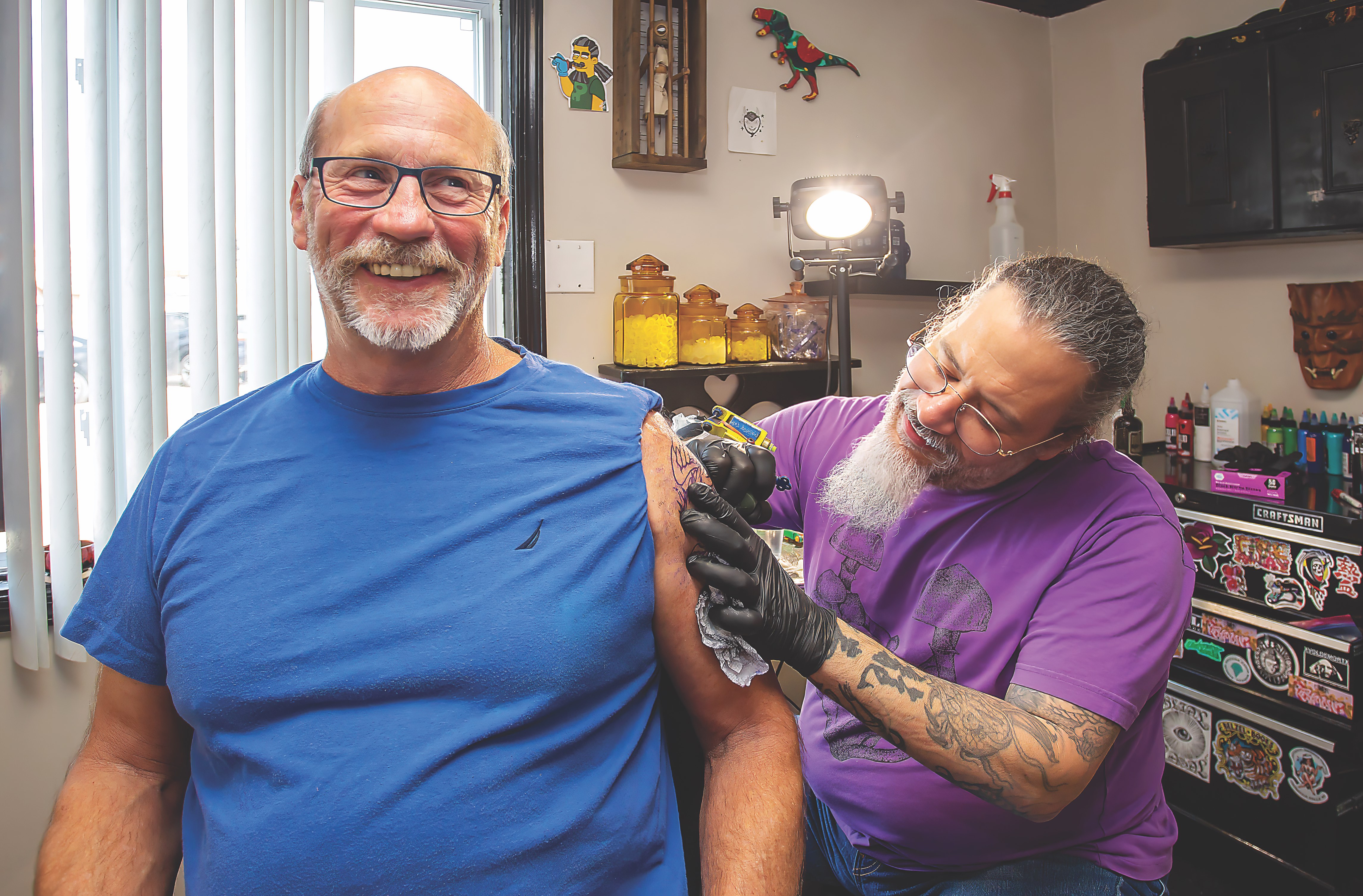
Tattooists leave an indelible mark on many a beachgoer. That’s by design.
By Bill Newcott
Photograph by Carolyn Watson
From the August 2023 issue

My friend Bill Brown knows for sure why he wants a phoenix, the mythical bird that rose from its own ashes, tattooed on his upper left arm.
“I’ve come through a lot,” he explains, without really explaining too much.
On his phone, Bill’s even got a photo of a phoenix tat that he found online: a wispy black avian with triumphantly outstretched wings.
Matt Brownlee, a veteran artist at Tough Luck Tattoo near Lewes, takes Bill’s phone in his hands for a better look.
“Is this exactly what you want?” he asks, his face expressionless.
“I’m not married to it,” says Bill.
Brownlee smiles thinly. It’s clear that’s the answer he was hoping for.
“Let me show you some other ideas,” he says, brandishing an iPad. Scrolling slowly, he rolls through a dizzying selection of phoenix tattoos: Some simple, some wildly elaborate. The styles range from a stark Native American-inspired design to a swirling, finely detailed bird that resembles a coiled, somewhat threatening, eagle.
Bill’s eyes light up at the eagle/phoenix.
“That’s pretty nice,” he half-whispers. The eagle/ phoenix it will be.
This is strictly an unverified observation, but it seems to me there’s a special affinity between tattoo parlors and the beach. From my childhood visits to Asbury Park, N.J., to my years living on Florida’s Gold Coast, concentrations of tattoo parlors seem to sprout at just about the point where you can start smelling saltwater. And here, from Milton to Fenwick, from Millsboro to Rehoboth Beach, barely a commercial block goes by without a storefront window advertising the services of a tattoo artist within; establishments with names like Tattoo Galaxy (Millsboro); Electric Tiger (Rehoboth Beach); and Ancient Art (Lewes).
Tough Luck Tattoo, with its staff of six artists, occupies a prime corner along Route 1, an ideal spot to catch the eyes of motorists crawling along in summer traffic. The interior of Tough Luck Tattoo might best be described as Early Eclectic Man Cave, with dozens of stuffed animal heads lining the walls along with lots of framed images ranging from vintage tattoo sample sheets to photos of a sneering, squinty Clint Eastwood.
I settle into one of the two large, comfy couches in Tough Luck’s front room, and I wonder if the place is ever crowded with people waiting here to be tattooed.
“Mostly, it would be a bunch of friends who’ll come in here together during the summer,” says owner Kris Dilworth, who’s been at the location for 15 years. “It’ll be kind of a party atmosphere. You know, they’ll get a palm tree or a wave; something that says ‘beach.’
“Tattoos are kind of a beach thing.”
Like every single tattooist I’ve met, Dilworth was an artist before he added “tattoo” to his professional title. “I was always drawing when I was in school,” he says. “Whenever there was a drawing contest, I would win. And one day, I saw a picture of my grandfather, who died before I was born. He was an Air Force pilot, and he had pilot wings tattooed on his arm. It just kind of resonated with me.”
Hawaiian by descent, Dilworth eventually discovered the long Polynesian tradition of body art. “That opened the door,” he says.
Whether they have a tiny heart hidden on an ankle or an Illustrated Man-level head-to-toe gallery, everyone with a tattoo shares one common story, and that is the story of their first tattoo.
“I was 16, and a buddy of mine said he wanted to get a tattoo,” Dilworth recalls. “He said he’d pay for mine. I got my mother to sign off on it.”
Really? How did that go down?
He laughs softly. “She was, like, ‘You have such beautiful skin! And you’re going to do this?’”
And so, at a biker shop, in the care of a guy with a cigarette hanging from his lips, young Dilworth embarked on his lifelong affair with tattoos.
“I picked out this crappy Grim Reaper holding a flame,” he recalls. “I’ve still got it on my back, but the guy wasn’t very good, and it faded. Now it just looks like a birthmark.”
Mention the name of Matthew Amey to just about any tattoo artist around here, and they will most likely nod respectfully. Amey was far from the first tattooist in the area, but he’s been here so long, and has trained so many others in his
Selbyville-area shop, that his reputation seems stenciled across the coastal Delaware tattoo subculture.
Amey has been tattooing clients for more than 30 years, and his Independent Tattoo parlor — a cozy space with a neat line of cubicles for a four-artist staff — has operated out of the same building along Lighthouse Road since 1997. You might mistake the place for a funky dentist’s office if not for, at one end, a red neon “TATTOO” light.
And he owes it all to Fat Larry.
Growing up in Salisbury, Md., he says, “tattooing was not on my radar. In high school, I just wanted to make art.”
In 1990, after his first semester at what was then called Salisbury State University, Amey decided to celebrate with a small tattoo on his ankle. But the nearest parlor he could find was 15 miles away, in Laurel, Del.
And that was where he met Fat Larry.
“He was a typical biker in a typical biker shop,” Amey notes. “He painted houses during the day and ran his tattoo shop at night. As he did the tattoo on me, I’m watching him. And I’m like, ‘Man, that looks easy. I could do that.’”
Amey asked Fat Larry if he could apprentice with him, but the tattooist already had an assistant. Undeterred, Amey decided to teach himself the art of tattooing.
“There was no internet,” he recalls. “There was no easy access to equipment. So I actually had to scope out bookstores that carried tattoo magazines, and the only ones I found were in Ocean City.”
On the back pages of those magazines, Amey found ads for tattooing equipment. He ordered some and, in what can only be described as the ultimate testament to male bonding, “I started practicing on friends,” he says.
Amey had found his life’s work. “I went to maybe two weeks of my second semester at Salisbury,” he says. “And then I never went back.”
On a couch in his mother’s house, sometimes at the dining room table, Amey injected his pals with permanent ink creating progressively more elaborate designs. “I’d go with my friends to college parties, and people would see their tattoos and ask, ‘Who did that?’ They’d say, ‘My buddy, right here.’ And they’d say, ‘I want one, too!’
“It just sort of ballooned from there.”
Matt Brownlee has returned from his drafting table at Tough Luck Tattoo. He’s created a really superb eagle/phoenix design for my friend Bill; one specifically scaled for his upper left arm.
Brownlee has inked the design onto a piece of porous paper that, following Bill’s approval, he applies to Bill’s arm, which has been coated with gel. Carefully, he peels away the paper — which leaves an exact copy of the design on Bill’s arm. This will be the template for the hardcore tattooing process.
“OK,” Brownlee says. “Here we go!” With deliberate caution, he raises his tattooing needle, which is powered by electrical impulses that will indelibly inject black ink into the dermis of Bill’s arm. He’s done this thousands of times, but there is a solemn, almost reverent, air to the moment. He presses a foot switch. A gentle whirr fills this small cubicle. The needle goes to work. Bill doesn’t exactly wince, but he doesn’t look particularly comfortable.
“Does it hurt?” I ask.
“It’s not bad,” he says. But I think it might be at least a little bad.
(I must say a word here about my friend, Bill. When the guys at Tough Luck offered to tattoo me as part of my research for this piece, I timidly demurred. I’ve got a thing about needles, you see, and while I am far from being an anti-vaxxer, if that syringe isn’t going to save my life, I’m going to give any kind of injection a hard pass.
(But I thought of Bill because he’s from Philadelphia — where he worked for the mayor’s office and has had, let’s just say, a colorful past — and I just assumed was a tattoo kind of guy. To my surprise, Bill had just one tiny tattoo: a now-blurry star on his upper left arm, applied by a buddy at the Jersey Shore when he was 17. Nevertheless, Bill enthusiastically accepted my offer, which is a testament not only to the power of friendship but also to the patience of Bill’s long-suffering wife, Cathy.)
Brownlee has been working at Tough Luck Tattoos for just over a year. But he and Dilworth both hail from Philadelphia, and both attended the now-closed Art Institute of Philadelphia before immersing themselves in tattoos full time.
Like all the tattoo artists I’ve encountered, Brownlee and Dilworth are both keenly aware of the fact that they are leaving their mark on their clients, literally, for the rest of their lives. Often, they find themselves walking a tightrope between giving their clients what they want and advising them against possible rash decisions.
“People have things tattooed on themselves that either come from a moment of passion or a moment of ignorance,” Brownlee says. “For instance, I had a kid come in years ago who insisted on having YOLO tattooed on his chest.”
For the uninformed (like me), YOLO — short for You Only Live Once — was all the rage around 2012, when the Canadian rapper Drake popularized it with a brand of merchandise. Unfortunately for that young tattoo customer, the slang term has since gone the way of The Cat’s Pajamas and So’s Your Old Man.
“So, he comes in years later,” Brownlee recalls, “and he’s got this YOLO on his chest — a dopey thing that no one says anymore — and it just shows the world how he makes bad decisions.”
In the end, Dilworth says, “you can’t save people from themselves. There are some psychological tricks you can use; ways you can steer the conversation. For example, you can show them a sample of what they’re asking for, and the thing that you think would work better.”
At times, more extreme measures are necessary. Amey at Independent Tattoo recalls the time a guy showed him a picture of the exact tattoo he wanted: a swastika.
“I told him, ‘I’ll do this tattoo. And I’ll put it up on your neck; maybe up on your cheek a little bit. And I’ll charge you 500 bucks.’
“He said, ‘Well, I was thinking down on my leg.’ And I said, ‘No, I’m only going to do it up where the whole world can see what an a-hole you are.’
“He said, ‘That’s f-ed up.’ And I pointed at his tattoo photo and said, ‘No, that’s f-ed up.’ So it’s an interesting industry, for sure.”
Janine Bond has been a professional tattoo artist for just six years, but even she knows the absolute worst mistake a client can make: Having the name of a loved one embedded in your skin.
“That is the kiss of death,” she says. “I don’t care if you’ve been together for 30 years. The moment a couple has their names tattooed on them, everything seems to go south.
“And it’s not just couples. I’ve cautioned parents when it comes to their kids’ names. Do you want to be the jerk who has their kid’s old name tattooed on them if they happen to transition? It happens!”
Even something as benign as the name of a celebrity or band can be fraught with danger. “I really would like to ask that kid how he feels about his Kanye West tattoo about now,” she says.
I have found Bond at work in a bright room at the very back of HeartDrawn Studio & Tattoo near Lewes, a brightly lit, three-artist business with the friendly vibe of a spa — if that spa were decorated with a seated skeleton wearing a fedora. On the walls are designs and illustrations by Bond, a relatively rare breed of tattooist who, rather than sketching out her work on paper, gets right down to business on a client’s bare skin.
I’m a little nervous about interviewing Bond right now, because she is at this moment creating a freehand tattoo on the leg of a client: a finely detailed dragon, based on a porcelain figurine the woman has brought in for the occasion.
“Nah, don’t worry about it,” she reassures me. The client, equally willing, says, “Go ahead. It’ll be fun!”
Bond is a true Delawarean, a graduate of local public schools. She studied fine arts at the Delaware College of Art and Design and the Maryland Institute College of Art, and considers herself an academic.
“If I could afford to be a career student, I probably would be,” she says.
Not surprisingly, humanity’s long, intimate relationship with body art fascinates Bond. She finds irresistible the fact that Europe’s oldest known mummified human — the approximately 5,300-year-old Alpine man known as Otzi — was found to have tattoos on his leathery skin.
“So body modification has been part of our history and culture pretty much forever,” she says.
Besides a wool cap — from under which an elaborate tattoo tumbles down the side of her face — Bond is wearing a long-sleeved Japanese Shinobu anime shirt, which recalls her earliest attraction to the tattoo art.
“This may reveal what a dweeb I was as a kid,” she confesses, “but certain anime characters had tattoos that I wanted to replicate. I just thought that would be badass.”
It is undeniably true that Bond herself is just as badass as any of the guys I met wielding tattoo needles — in some ways, maybe more so.
“It’s definitely a male-dominated field,” she says, focusing her attention on one claw on the dragon tattoo-in-progress. “But I think more and more people — even men — are going out of their way to [seek] female tattoo artists.”
There are two reasons for that, she says. One is that too many men in the business have what she calls “god-like” egos.
The second reason is more palpable: Women tend to be less “heavy-handed” than their male counterparts. Literally.
“I have had some dudes who, when they’re doing a tattoo on me, really, really break my skin,” she says. “I have one friend who’s a tattoo artist; I really love him, but there’s a reason we call him The Hammer.”
Three hours from the moment we walked into Tough Luck Tattoo, Bill’s eagle/phoenix is finished. After taking an hour to draw the bird’s outline in black ink, Brownlee settled into the painstaking process of shading and coloring, giving Bill’s eagle/phoenix an uncanny 3D quality. If we were in a Popeye cartoon, I thought, the one-eyed sailor would flex his biceps and the thing would take off with a loud squawk.
After that initial flinching, Bill seems to have come to terms with the inherent sting of tattoo application.
“After a while you kinda get used to it,” he tells me. For the next several days he will have to take care of his new body art — which is, after all, the result of what amounts to a medical procedure. No direct sunlight for at least a month; regular moisturizer and cleaning with antibacterial soap; absolutely no scratching or picking at it.
Plus, because of potentially infectious bacteria in seawater (see page 57), no near-term trips to the beach — a rule that often catches vacationers by surprise. Visitors typically find it best to get that palm tree or wave tattoo during their last day in town.
None of which is a concern for Bill, who is about to head home to proudly show his new body art to his wife, Cathy.
“You know,” he tells Brownlee and Dilworth as we head for the door, “I’m thinking about a dragon for my other arm.”
“We’ll be here!” Brownlee smiles.
Cathy, of course, will have the final say.



